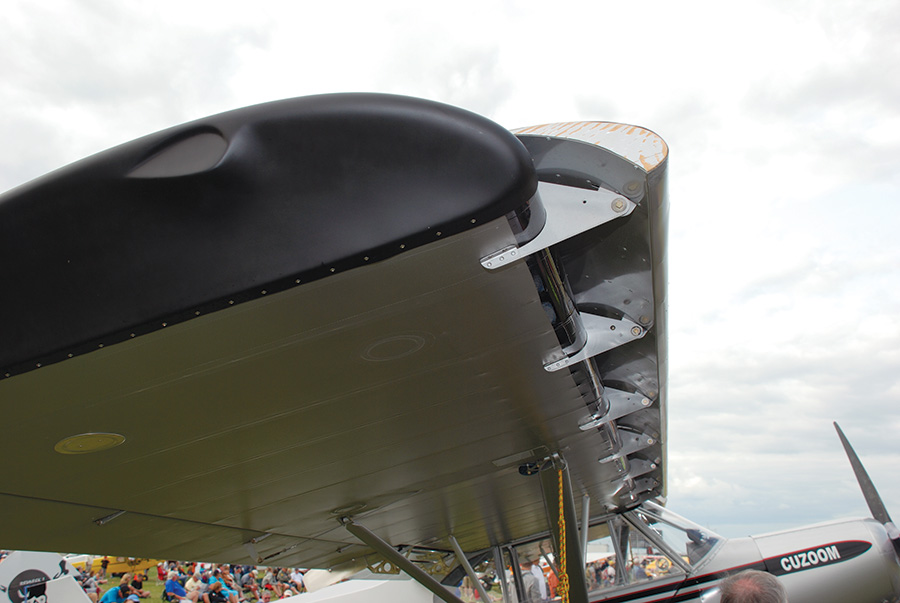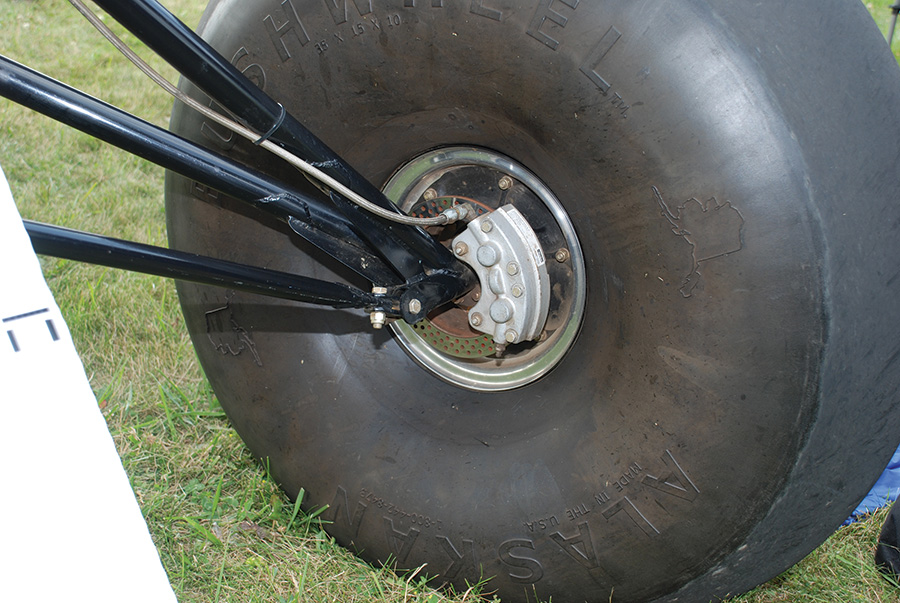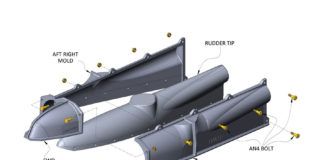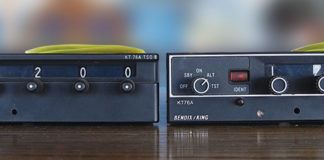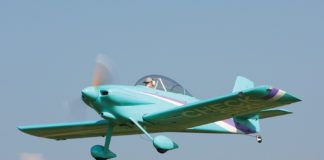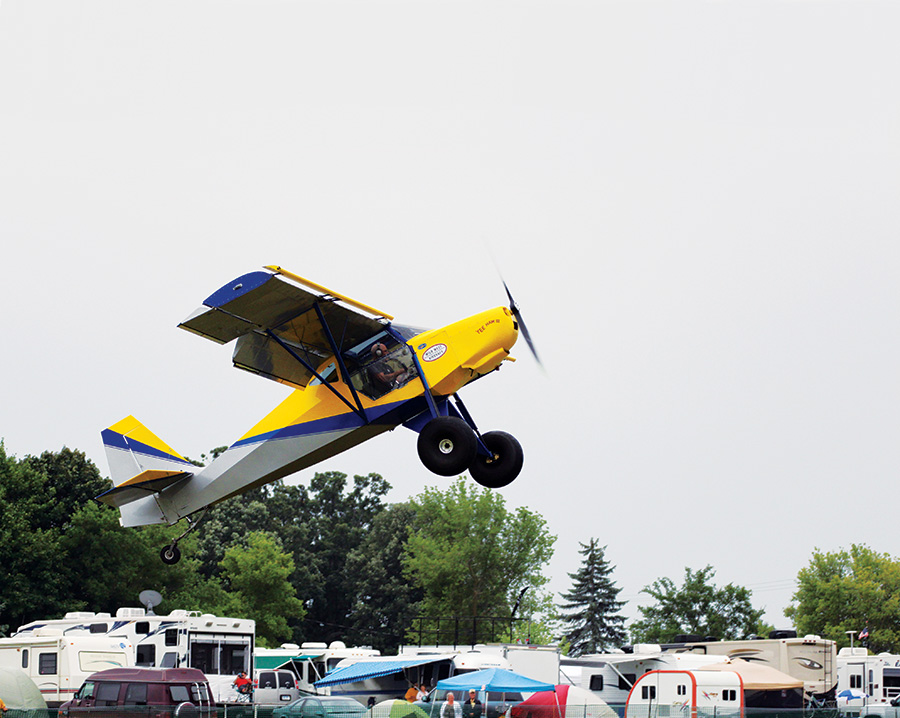
Steve Henry launches his Just SuperSTOL skyward in less than 100 feet at AirVenture. A 130-hp turbocharged Rotax 912 and Kiev prop provide the thrust.
The short takeoff and landing (STOL) competition held every May in Valdez, Alaska, has become legendary. What once was just a friendly contest between a bunch of bush pilots now garners national attention with the stunning performances of its competitors. As a special treat for those of us stuck in the lower 48, a number of these bush pilots came to AirVenture last year to put on an exhibition. It quickly became one of the highlights of the week, only taking a backseat to the Air Force Thunderbirds in popularity.
If you think a 500-foot landing is pretty short (and it is for most people), you haven’t seen anything until you watch these pros in action. At Valdez this year the top three Experimentals all landed in less than 50 feet, and the best certified airplane needed only five feet more than that. Takeoffs were equally impressive, with the top four pilots needing well less than 100 feet to get airborne. Scoring consists of adding your best takeoff roll to your best landing roll and pitting that total against the other competitors. The top two competitors in the Alternate Bush (Experimental) Class had totals of less than 100 feet. Steve Henry’s Just SuperSTOL came in at 120 feet total, which was only good enough for third place. Bobby Breeden posted a most impressive score of 116, beating his father by three feet, in a certified PA-18 Super Cub. These guys don’t need runways, a football field is more than enough.
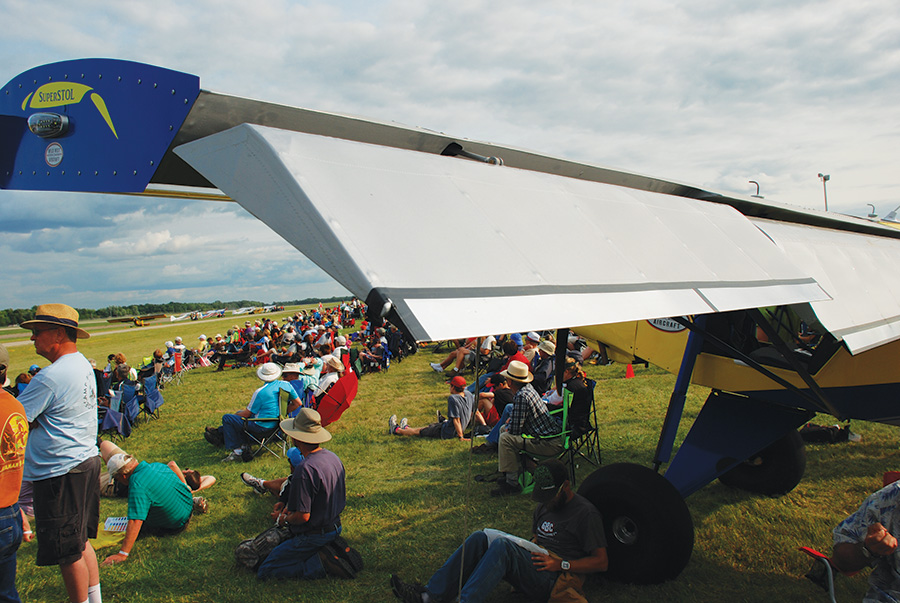
SuperSTOL pilot Steve Henry is experimenting with extended flaps and ailerons to gain that extra edge.
Technique
The flying is pretty straightforward, which is not to say easy. Roll up to the line, apply full power, lift the tail, push the stick forward as you release the brakes, making sure you don’t dig the prop into the runway, and when you get to flying speed pull back and away you go. Once off the ground push the stick forward again to gain some speed and come back for a short landing. Of course, if you push the stick too far forward you will need a new propeller and an engine teardown. If you pull the stick back too soon you will slam the tailwheel down on the runway, lose your chance at a really short takeoff, and maybe bend your airplane. The process is simple, but the execution takes a lot of practice, and taking off is the easy part.
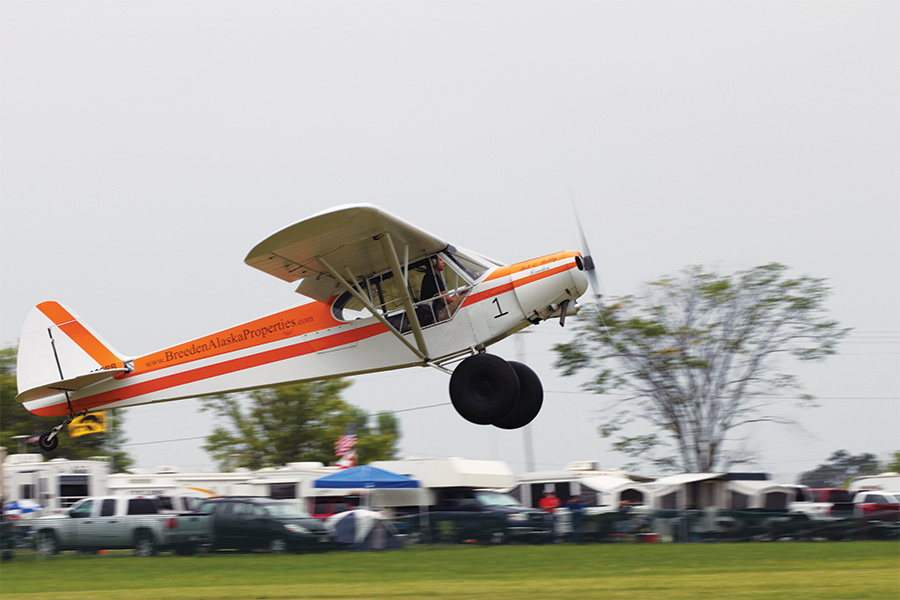
The Breedens’ simple modifications are limited to big tires and vortex generators, showing that good flying can go a long way toward achieving good results.
The secret to a short landing in competition is being able to hit the landing spot just inches past the line. Every good short landing begins with hitting your landing spot dead on. Floating 100 feet past your target is just as bad as adding 100 feet to your ground roll. On a 3000-foot runway it is no big deal; on a 300-foot sand bar in the middle of a river it is a very big deal.
The typical landing begins with a power-on approach at just above stall speed. This requires precise flying and can be a real challenge in shifting winds. This is why most bush flying is done in the morning when winds are likely to be calmer. At AirVenture the competition was held in the late afternoon, giving the pilots a real workout. A slow and stable approach must aim for a point a bit short of the intended landing spot to allow for the float that any plane will have in the flare. At lower speeds there isn’t much float, but remember, we are talking about real precision where a few feet matter. This aim point will vary depending on the plane and the wind, so this is a feel that must be developed with a lot of practice.
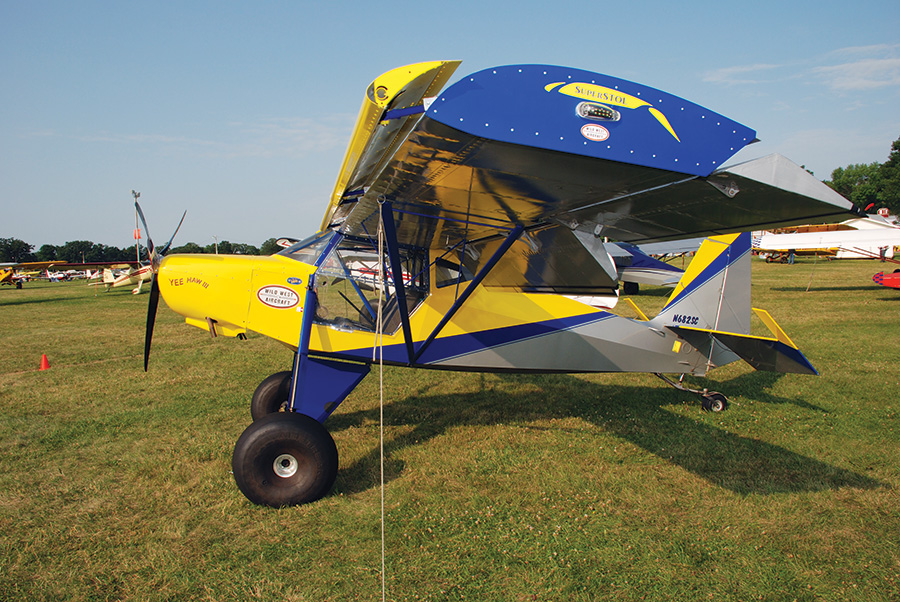
The Just SuperSTOL also features Helio Courier-type slats, but the mechanics are somewhat different. Just’s Troy Woodland came up with an extension mechanism that is much easier to build, but just as effective as the Helio Courier system.
The actual landing technique can vary, but tail-low wheel landings seem to be popular. There is no penalty for hitting tailwheel first, but that can be hard on a plane and is generally not favored. The Just SuperSTOL can easily take such abuse, but the Super Cubs are less sturdy in this regard. With the mains touching down just over the line (hopefully), hard braking brings the plane to a quick stop. Four puck brakes are standard to stop the plane quickly and arrest the rotation of those big tires. The trick is to put the brakes on hard, but not so hard as to pitch the plane’s nose into the tarmac. Most planes have their landing gear set forward to help alleviate this forward pitching motion, but accidents still happen almost every year. Again, practice makes the difference between merely good and a real winner. If you have done everything just right, you have used less than 100 feet of runway. If not, there is one more chance, or try again next year.
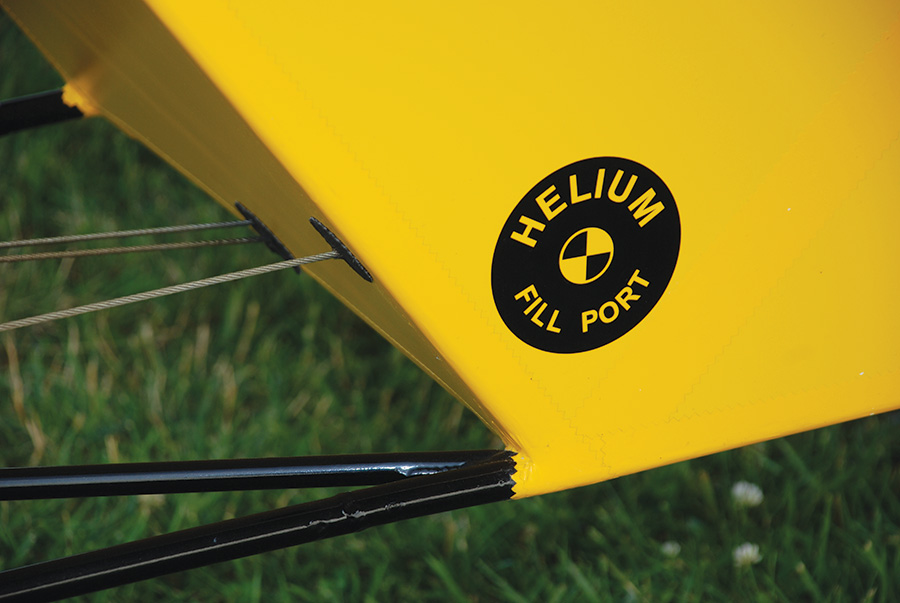
Despite rumors to the contrary, Frank Knapp does not really fill his plane with helium to gain extra lift.
Low Weight, High Lift
As in any competitive motor sport, everyone wants to get an edge by having the best equipment possible to maximize their advantage over the competition. Sometimes too much emphasis is placed on the equipment and not enough on the pilot, but there are definitely modifications that can make a big difference. Let’s see what some of the Valdez competitors have done to get that extra edge.

Many planes use gap seals on various flight control surfaces to improve lift and control effectiveness.
To take off quickly, in the shortest distance possible, you need the maximum amount of lift and the minimum amount of weight possible. You then need enough thrust to accelerate the plane to a speed sufficient to produce that lift quickly. Many people focus on the thrust part of the formula, going for the maximum amount of horsepower, but the real secret is found in minimizing weight. Less weight accelerates more quickly. Frank Knapp wins every time with a plane that is powered by a little Continental O-200, but his plane has a huge wing and weighs less than 700 pounds. It is fair to say that this does not make for a very useful airplane outside of competition, but it surely drives home the point that more lift and less weight are the keys to getting off quickly. The practical implication of this is that if you want a bush plane that will land and take off well, you need to keep your weight to a minimum. This has been the key to the Carbon Cub’s impressive performance. It is simply 200 pounds lighter than the typical Super Cub. Steve Henry’s Just SuperSTOL also benefits greatly from its low weight of a little over 800 pounds. The very impressive performances of the father and son Breeden team owes much to keeping the empty weight of their Super Cub to a minimum. Plus, they can really fly that plane.
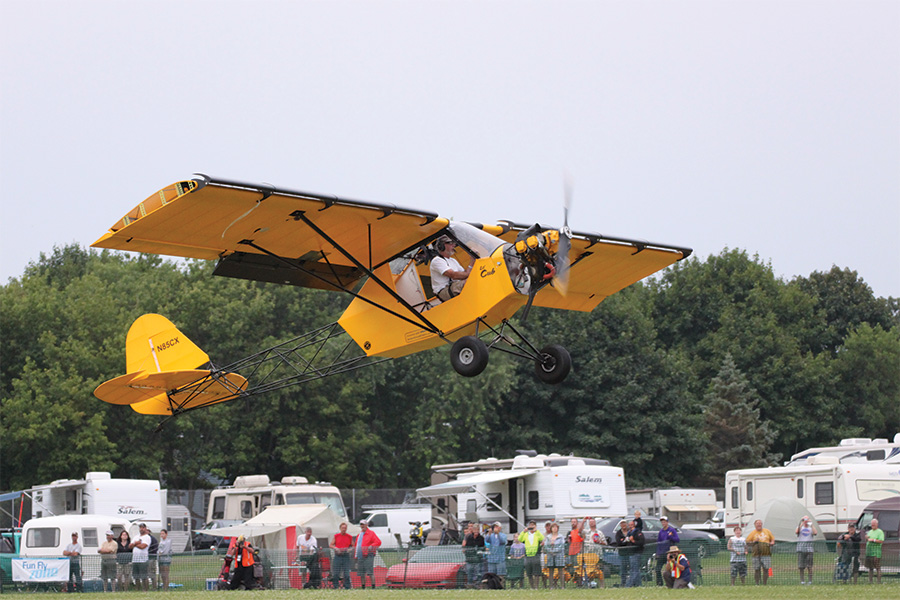
Frank Knapp’s Lil’ Cub is the ultimate expression of simplicity—maximum lift and minimum weight. There is nothing that is not needed for STOL competition, making him pretty much unbeatable.
Vortex Generators
If low weight is important, so is high lift, and many STOL modifications are aimed precisely at that. Vortex generators (VGs) are almost a universal modification because they lower stall speed by keeping the airflow attached to the top of the wing longer. This is probably the cheapest, most effective STOL modification available, and there are STCs available for most certified airplanes, so this enhancement is not just limited to Experimentals. There is some debate as to where on the wings vortex generators should be located and how far apart they should be spaced, but there seems to be no disagreement about their effectiveness.
Another place where many STOL pilots like to use VGs is on the underside of the horizontal stabilizer, just in front of the elevator. This seems to help maintain the effectiveness of the elevator at very low speeds. This is important because the elevator controls pitch. Operating on the ragged edge of a stall as these planes do, pitch control is vitally important. The next time you see a Super Cub with VGs on the wings take a look under the tail and see if they aren’t there, too.
Gap Seals
One way to enhance lift is to prevent high pressure air below the wing from flowing to the lower pressure areas on top of the wing. Gap seals help to prevent this airflow by sealing the gaps between the ailerons and wings, between the flaps and the wings, and between the horizontal stabilizer and the elevator. Gap seals can also improve the effectiveness of the rudder by sealing up the gap between the vertical stabilizer and the rudder. Many of the Valdez pilots at AirVenture used gap seals in one or more places to preserve lift and increase control effectiveness. The improvements produced by gap seals are sometimes rather small, but when maximum performance is needed, every little bit helps.

Oversized Performance STOL slotted flaps that extend to a full 90 degrees provide extra lift and drag to Mike Olson’s Cuzoom bush plane.
Slats and Flaps
The granddaddy of STOL planes, the Helio Courier, is famous for its slats that pop out when the angle of attack calls for them. All of this is aerodynamic and unpowered, unlike the slats on a modern airliner. Slats lengthen the effective chord of the wing, thus increasing its lift, and help to channel air over the top of the wing at high angles of attack. They are effective, but add weight and complexity. The Just SuperSTOL is noted for its revival of the Helio-like slats that pop out when needed, but Just is not the only one to use this aerodynamic trick to create more lift. Backcountry Cubs and Dakota Cubs both offer their own versions of slats or slots to enhance STOL performance. Dakota uses a fixed slot to enhance lift, and Backcountry uses a hinged slat to do much the same thing. Wayne Mackey, the man behind the Backcountry slatted wing, designed a plane that took second place at Valdez this year with a takeoff of 37 feet and a landing of 46 feet. The Experimental Pegazair, now available as a kit, uses slats that are almost identical to the Helio’s.
Oversized and extended flaps are also popular among those who seek the shortest possible landing roll. Perennial competitor Mike Olson sports long flaps that will extend to 90 degrees. He also has a special control that allows him to quickly release his flaps when needed. SuperSTOL pilot Steve Henry also extended his flaps for the AirVenture competition.

This Pegazair Experimental uses Helio Courier-type slats to gain extra lift. They extend automatically at high angles of attack.
Thrust—Engines and Props
Many competitors put a great deal of energy into getting more power from their engines, sometimes to the detriment of other important factors such as weight and reliability. That said, a plane will not take off without thrust, so an effective combination of engine and prop is important. Most bush pilots use some version of the Lycoming O-360 engine, but some use the smaller, lighter O-320, and CubCrafters uses their own powerplant based on a Titan ECi O-340 engine. However, there are those who just can’t get enough horsepower and are willing to go to great lengths to get it. Mike Olson has a custom-built engine with electronic fuel injection and ignition, and a nitrous oxide system that gives him a 100-hp boost when he hits the switch. This gives him well in excess of 300 horsepower for short bursts. Unfortunately at AirVenture his engine was not behaving very well, so we were unable to see the impressive potential that such power promised. A few other competitors are experimenting with nitrous oxide, but be warned, this is not for the faint of heart or thin of wallet. This modification is easy to get wrong, and getting it wrong usually involves a lot of new engine parts. Even when it works it puts a great deal of strain on the engine.
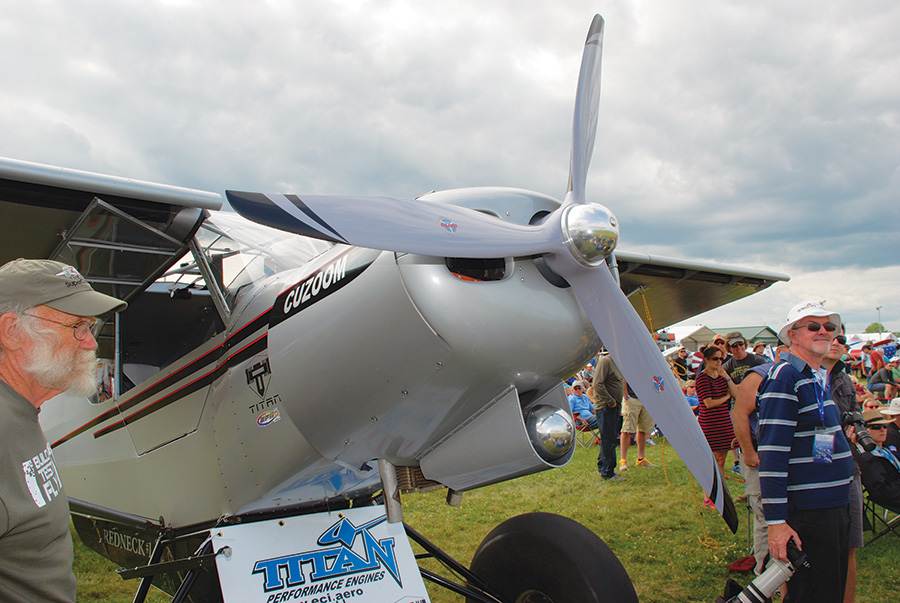
Cuzoom sports a 3-blade Catto prop with a diameter of 78 inches. Craig Catto has become something of a rock star with the Experimental STOL set.
The Titan ECi O-375 engine has enticed a number of Experimental builders with its extra 20 hp at the same basic weight and size as an O-360. And not to be left behind, Superior is soon coming out with its XP-382 engine, also based on the O-360 platform.
The prop plays a vital role in producing thrust, so it is no wonder that a great deal of energy goes into finding the best prop. The traditional setup is the McCauley Borer prop. These are metal, fixed-pitch props with a diameter of about 82 inches and a pitch of 38 to 44 inches. They are at the extreme end of what you would call climb props. They aren’t much good for cruise flight, but they will pull like a tractor when you need to get off the ground in a hurry. These props are well-proven, but the Experimental crowd has largely abandoned them in favor of much lighter composite props. In particular, they have been beating a path to Craig Catto’s door in Jackson, California. The Catto prop will pull as well or even better than the McCauley and weighs almost 40 pounds less. Those seeking the versatility of a constant-speed prop have been favoring MT or WhirlWind composite props, but the hardcore competitors are sticking with fixed props for their lighter weight.
Please note that not every engine and prop will work well together. Be sure to consult with the propeller manufacturer to see if there are any compatibility issues or rpm restrictions with your engine and prop combination.
Tires and Gear
Everyone uses big tires, typically Alaskan Bushwheels in the 29- to 35-inch range. Some Light Sport planes will opt for the smaller, lighter 26-inch tires. In the field these big tires allow planes to land on rough and rocky clearings that would rip the landing gear off of a conventional airplane. They just roll over head-sized rocks without complaint. They also help to provide better ground clearance for big props. In competition they allow a higher angle of attack when pitching up for takeoff and again provide extra ground clearance for big props. This is especially important under hard braking when the nose tends to pitch downward. On the negative side, they add weight and their rolling inertia must be overcome by larger brakes when a quick stop is needed. The other negative is that a pair will cost $3-$4,000. These complaints aside, only Frank Knapp goes without the big tires among the STOL competitors.

Gear legs that are extended in length and angled forward are common on bush planes such as this custom-built Super Cub.
Landing gear is a less obvious, but equally important, STOL modification. Most landing gear is extended in length, which moves the axles forward. The original bush landing gear added three inches to the length and set the mains forward three inches. Now it is common to see much more radical modifications. For example, Mike Olson has extended his gear 12 inches and moved the axles eight inches forward. The bush gear option on the Glasair Sportsman extends the length by six inches and sets the axles forward by an equal amount. The benefits are more propeller clearance and a reduced tendency to nose over under hard braking. The negative of extended gear is that it places more weight on the tailwheel, which is usually a rather weak point on most bush planes.
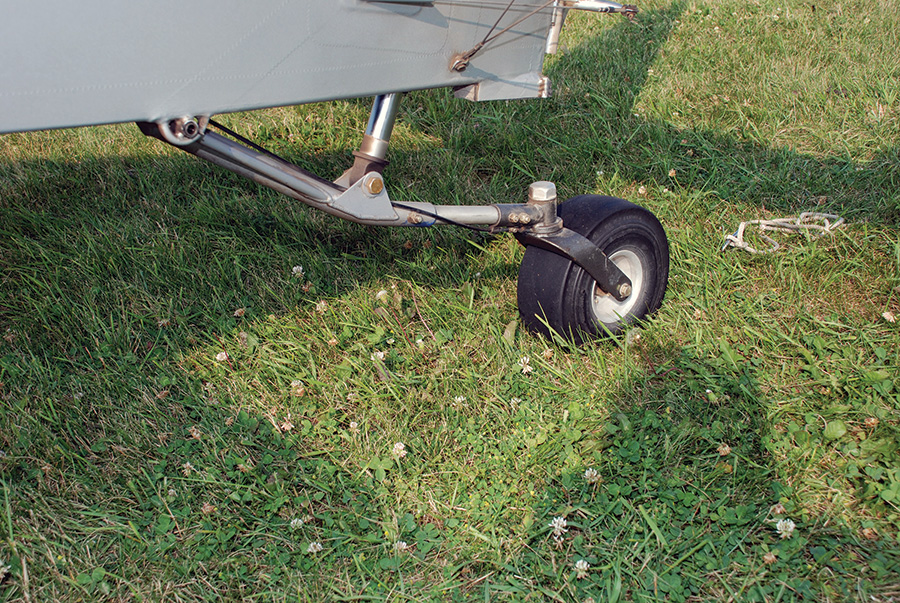
The Just SuperSTOL features a nitrogen shock and swing-arm suspension for the tailwheel, making it possible to absorb some pretty firm landings without damage.
Practice
With all of this said, the most important modification you can make to your plane if you are serious about STOL flying is to improve the pilot. An ounce of focused practice is worth a pound of STOL mods in most cases. Learn how to control altitude and airspeed precisely. From there you can progress to learning how to hit a landing spot precisely. This takes some training and a whole lot of work. You don’t need a bush plane to develop these skills, any plane will do. If you can hold the altitude of your RV-6 to within a few feet and airspeed to within one knot, you will have skills that will easily transfer to a bush plane. Practice hitting your landing spot within a few feet every time you land. This is learnable stuff. These STOL competitors are not supermen; they have just worked at these skills harder and longer than most other people.
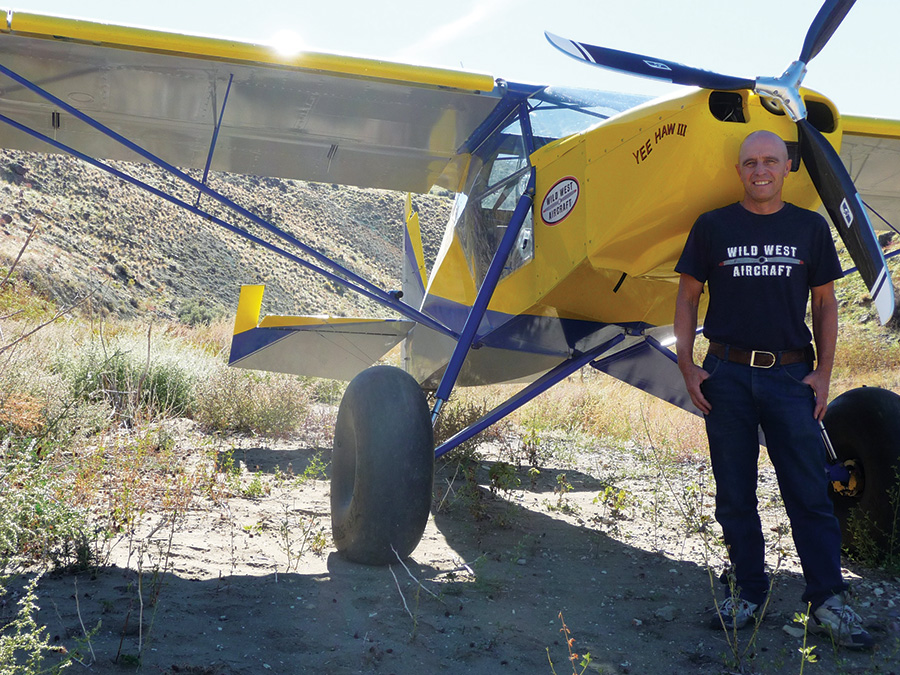
Steve Henry (a.k.a. Dead Stick Steve) gained fame from a YouTube video in which he rolls off a cliff and glides to a landing below with the engine shut off. He flew a Just Highlander in the video, but has since built a SuperSTOL. (Photo courtesy of Steve Henry)
As the owner of an Experimental airplane, you are free to make modifications to your heart’s content, but be sure to consult and comply with your operating limitations if you do. At least some of these changes will be considered major modifications that require re-entering Phase I flight testing. It is also a good idea to make one change at a time and evaluate it before adding more modifications. At all times be careful and stay safe. Take on greater challenges only as your skills develop.

